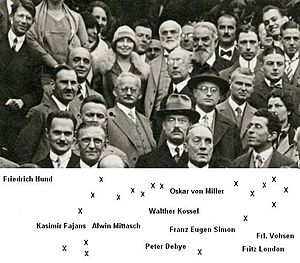Kazimierz Fajans facts for kids
Quick facts for kids
Kazimierz Fajans
|
|
|---|---|

Kazimierz Fajans
|
|
| Born | 27 May 1887 Warsaw, Poland
|
| Died | 18 May 1975 (aged 87) Ann Arbor, Michigan, United States
|
| Known for |
|
| Scientific career | |
| Institutions | University of Michigan University of Manchester |
| Doctoral students | Theodore H. Berlin |
Kazimierz Fajans (born May 27, 1887 – died May 18, 1975) was a Polish-American scientist who studied chemistry. He was one of the first people to explore radioactivity. He also helped discover the chemical element protactinium.
Early Life and Education
Kazimierz Fajans was born on May 27, 1887, in Warsaw, which was then part of Congress Poland. After finishing high school in Warsaw in 1904, he went to Germany to study chemistry. He studied at universities in Leipzig, Heidelberg, and Zürich.
In 1909, he earned his PhD degree. His research was about making special chemical compounds that have a unique shape, like a left or right hand.
Career Journey
In 1910, Fajans started working at the laboratory of Ernest Rutherford in Manchester, England. This was an exciting place, as Rutherford's team had just discovered the nucleus of an atom.
Later, Fajans returned to Germany. He became an assistant professor at the Technical University of Karlsruhe. There, he focused his research on radioactivity. In 1917, he moved to Munich University to lead the Physical Chemistry department. In 1932, he became the head of a new institute for physical chemistry.
In 1935, Fajans left Germany. This was because of difficult times in Germany due to the Nazis. He first stayed in Cambridge, England. Then, he moved to Ann Arbor, Michigan in the United States. He joined the faculty at the University of Michigan, where he continued his important work for the rest of his life.
Even after he officially retired at age seventy, he kept working. He passed away on May 18, 1975, in Ann Arbor.
Amazing Discoveries
While working with Ernest Rutherford, Fajans studied how radioactive elements change. He figured out how long it takes for half of certain radioactive elements, like uranium and thorium, to break down. This is called their half-life.
He also discovered how radioactive elements can change in different ways. Fajans then created a rule about how elements change when they are radioactive. This rule is now known as the radioactive displacement law of Fajans and Soddy. Another scientist, Frederick Soddy, also worked on this and won a Nobel Prize for his research.
In 1913, Fajans and Oswald Helmuth Göhring discovered a new radioactive element. It was later named protactinium. Fajans and Otto Hahn also found a way to figure out how radioactive substances can be separated and cleaned, even when there are only tiny amounts.
Later, Fajans started studying the structure of particles and crystals. He looked at how strong chemical bonds are and how ions (charged atoms) and particles can change shape. In 1923, he created Fajans' rules. These rules help scientists predict if a chemical bond will be covalent (sharing electrons) or ionic (transferring electrons).
In the United States, Fajans used a machine called a cyclotron to study nuclear reactions. He discovered new radioactive forms of lead and rhenium. He also developed a theory called the "quanticule theory." This theory helped explain how chemical bonds work based on how tiny particles interact.
Fajans was a member of many important scientific groups and academies.
See also
 In Spanish: Kasimir Fajans para niños
In Spanish: Kasimir Fajans para niños


